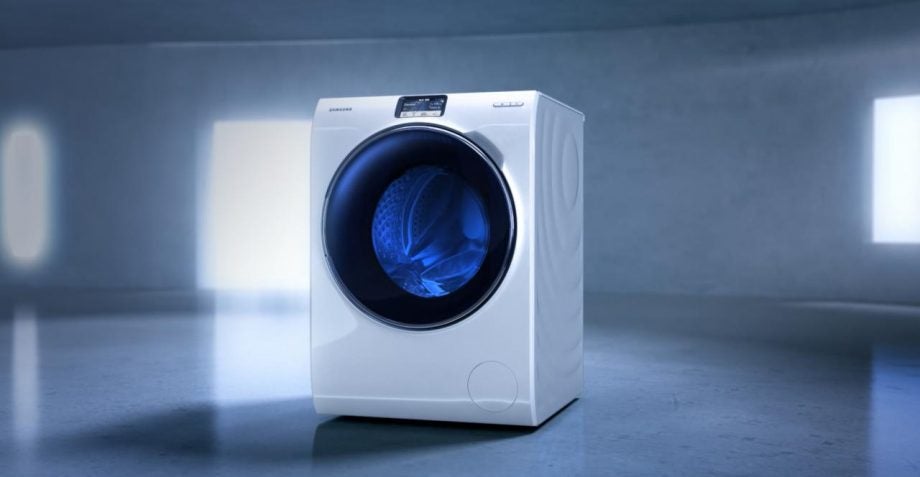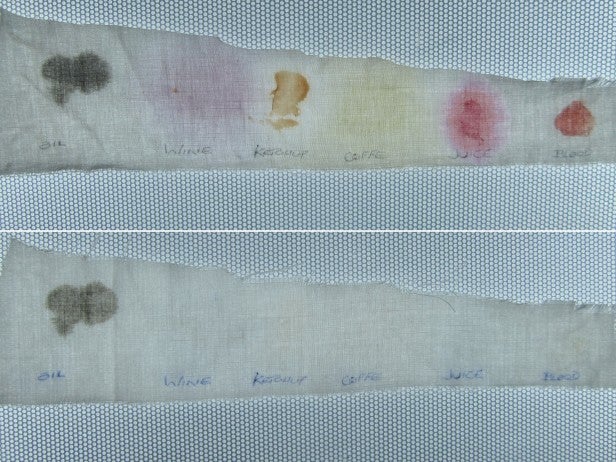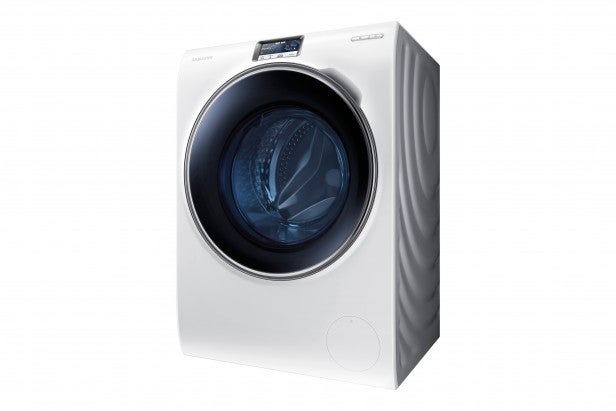Samsung WW9000 Review - Performance and Verdict Review
Performance and Verdict
This app-controlled spinner is the smartest washing machine around

Sections
- Page 1 Samsung WW9000 Review
- Page 2 Performance and Verdict Review
Samsung WW9000 – How well does it wash?
As usual we ran three different wash cycles for our tests: a 40°C cotton wash with a 8kg (80%) full load at 1600rpm spin speed, a 40°C normal cotton wash with a 4kg (40%) load at 1600rpm spin speed, and then the same load but this time on the machine’s Eco mode to see how much energy it could save. The Eco mode is limited to 1200rpm to save energy, so the spin results in this mode would be very interesting.
A well-matured test stain strip went into the first wash, stained with dried-on ketchup, coffee, blood, red wine and engine oil. We loaded the WW9000 with non-biological detergent, so it had no ‘technical’ help from the powder, and set about the test programmes.
High-tech, energy-efficient washing machines are many things, but ‘quick’ isn’t one of them when they’re in full programme mode. While quick-wash modes are available, the first main wash ran over by 5 mins on the 3 hrs 5 mins the machine initially stated. The wash with the half-load, on the other hand, was 6 mins quicker than the 2 hrs 18 mins stated, and the final Eco wash ran over by just 2 mins on the 1 hr 55 mins indicated. If the washing is more heavily soiled or really mucky, the programmes are likely to take a little longer thanks to the WW9000’s sensing technology.
With all this technology at our disposal, the test team got rather excited to see the test-strip results when the first cycle came to an end. We were certainly not disappointed! The test strip came out exceptionally clean, with just the merest hint of the ketchup and blood stains remaining. As ever, the dirty engine oil hung in there tenaciously, but even this was reduced to a much lighter stain than we’re used to seeing. If you use biological washing powder, this test strip would be virtually pristine. The result is the joint-best wash performance we have seen, equal to Miele’s flagship washer.

Our well-smeared test strip before (above, obviously) and after. An excellent result
There was very little surprise, then, that the Samsung turned in spectacularly good spin results as well, removing water from our washing incredibly efficiently and reducing subsequent drying time. It worked at its best with a full load, leaving a little over 2 litres of water (26% of load weight) in the washing and just 1.3kg (32%) in the half load. The half-load Eco results went awry at 46%, but more on those issues later. Overall water consumption was very good at 21.7cu m per annum.
SEE ALSO: Best washing machine
Samsung WW9000 – How noisy is it?
Samsung’s brochure rather ambitiously states that the wash noise is just 46dB and the spin is a slightly more believable 71dB. The quietest washing machine we’ve ever tested, the stunning Miele WMR 560 WPS, is the only machine get close to these claims.
We tried several different wash cycles and measured somewhere between 48dB and 50dB of wash noise, and much of that was the water and clothes moving around, rather than the motor. The motor and drum itself move almost silently. A measured 48dB is still bonkers-quiet and means we had to test in the dead of night to reduce distant ambient noise low enough for the test equipment to pick up the washer noise. Think of a quiet whisper and you’re not far off. At full spin the WW9000 measured exactly the 71dB that the specification sheet claims, making it among the quietest we’ve tested.
It really is incredibly quiet. Well done, Samsung.
Samsung WW9000 – How much will it cost to run?
Chances are that if you’re happy to pay the Samsung’s £1700 asking price then the running costs aren’t going to be a huge concern. That said, running costs go hand in hand with a machine’s eco credentials, and we’re happy to report that the WW9000 is very much a green machine, using very little water or electricity. The full-load wash at 40 degrees cost just 17p, which is a small amount of electricity for the 8kg of washing on our test. The half-load wash proved even more frugal, using less than half the electricity for 4kg and costing just 5p a load.
Things went a little awry using half-load in Eco mode, actually using more water and almost double the electricity than the non-Eco mode. This isn’t the first time we’ve encountered this with washing machines made in Korea, and investigations thus far have indicated that the machines are engineered to meet some peculiar Korean tests in this mode that make the Eco setting pointless unless you’re using a full load. Our recommendation would be to use the WW9000 with a full load or half load without going near the Eco setting, as its results without the additional mode were up there with the very best anyway.
The poor half-load Eco results did add a few quid to the overall running costs to remain consistent with previous tests, nudging the overall annual running costs up to £37.29, which is still very respectable for a 10kg machine.
Should I buy the Samsung WW9000?
If you’re in the market for a money-no-object, high-performance washing machine, your options are limited to the aforementioned Miele and Samsung’s WW9000 at the moment. While both offer sector-defining wash performance, they approach the art of washing clothes in very different ways. While the Miele is undoubtedly the champion of engineering excellence and absolute efficiency, the Samsung is a close second in these respects and brings a whole host of smart features and programmes into the mix. Add in the stunning looks and the fact that programmes, operation and the app will no doubt improve with future software updates, and the WW9000 is the ultimate washing machine for anyone who wants to be at the forefront of technology – even in the kitchen.
Next, read more Washing Machine Reviews


